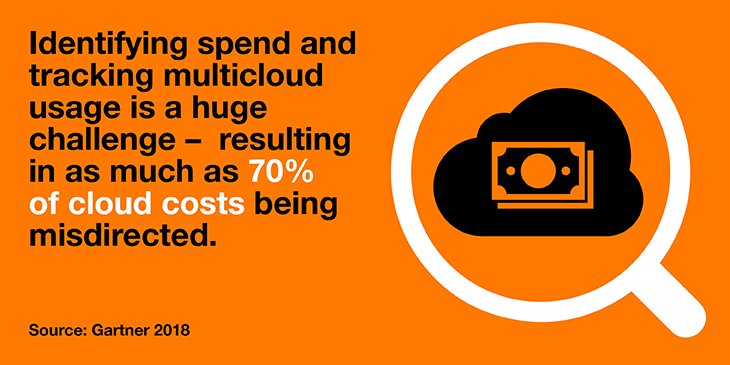Virtually all enterprises have cloud services – whether as shadow it, software as a service (SaaS) or some other XaaS. However, it may not be just the IT department, so overall visibility of spending and value is more challenging to manage, budget and control.
According to a survey by Forrester, 86% of enterprises are now moving on from just a single cloud to a multicloud strategy. Initially driven by CAPEX to OPEX financing benefits and looking for agility in developing and delivering new or enhanced services, investment in cloud technology is growing. Almost 50% of enterprises said their cloud spend is now at least $50 million annually, and there is consistent pressure to continue increasing adoption and so maintain or increase cloud spend over the next year and a half.
Enterprises see cloud as the answer to many different business objectives. Operational efficiency at 42% was ranked the main objective it could assist with in Forrester’s survey, followed by innovation and revenue growth. Cloud has the potential to reduce costs – but the big problem is that many enterprises tend to continue provisioning into the cloud using traditional methods, which results in over-provisioning of compute flavors, (CPU, memory) and storage overspends.
In fact, most enterprises overprovide in terms of capacity as a result of a lift-and-shift approach to migration into the cloud. Even green builds can be inefficient in design unless adopting new methodologies such as DevOps.
Cloud cost optimization is a process that looks at both capacity and performance in order to provide insight. Then, by assessing the data and reviewing any management policies, you can highlight resources that are under or over-utilized and provide guidance on the right sizing of services and ongoing changes to process and tooling that will assist in understanding and controlling future spend. Gartner estimates that as much as 70% of cloud costs are misdirected. At Orange Business, we have helped enterprises optimize the services they have purchased in terms of cost and performance.
Most enterprises expect that the cloud will provide cost savings, but to achieve this, you must start with the migration to the cloud: do you simply lift and shift current workloads, or can you transform or redesign the workload? Can you identify the applications and infrastructure that can be moved to the cloud to make the most economic sense, can they be resized during or after migration? Or do you simply build new in the cloud using updated methods and processes? Orange Business has a team of consultants, trainers, cloud coaches and cloud readiness assessment experts who can advise you about all of this and provide ongoing assessments of applications running in the cloud to ensure optimum value and performance.
Understanding the cloud landscape
Cloud transformation is a leap of faith. Time and again, enterprises find it difficult to realize the savings they hoped for when they migrate to the cloud. When you are progressing through your cloud adoption journey, you need to have cost management plans in place from the outset to control cloud spend.
Our team of experts can help if you are at the start of cloud migration or if you are already in the cloud. We run audits and cloud maturity assessments to draw up the best cloud routes, re-validating and reiterating the performance of cloud services against cost. You can incur extra costs with integration, for example. It is essential to plan ahead so you know what fees are likely and to be able to track your cloud bills going forward. Managing multiple providers and services, however, is a challenge, and why many enterprises are opting for multicloud management. Orange Business can support you here with cloud management platforms, providing a custom implementation to abstract management complexity.
Even once cost management has been achieved, it will be beneficial and good practice to set up a continual improvement process to maintain, if not improve, savings and achieve performance optimization benefits. This is a crucial commitment for enterprises if they are to harvest tangible business value from the cloud.

The question of vendor lock-in
Understanding the different cloud vendors’ offerings is central to any enterprise’s cloud-first strategy. At first glance, many cloud packages may look attractive, but dig a little deeper and there will be differences and charges not seen in on-premise, co-location or hosted platforms, such as network traffic egress. Some vendors charge differently by the second or by long-term commitment (reserved instances), which affects different workloads.
The problem of vendor lock-in still exists; you may use a vendor-specific feature not available from another provider. This risk needs assessing and understanding and really depends on where an enterprise is in its cloud journey. If you already have a cloud infrastructure, you may already be locked in to some extent. Whereas when starting out, it is easier to avoid unintentional vendor lock-in.
Our consultants find that enterprises that have moved their workloads are with a single provider. We advise them to assess the risks around disaster recovery and business continuity, for example, while also looking at the benefits of different features being offered by various vendors.
Vendor lock-in, however, isn’t always bad news. Enterprises can benefit from discounts and be among the first to get proof of concepts and new features.
Whichever route you take, it is important to carry out your research first. Our consultants can help you draw up a cloud roadmap based on your short-, medium- and long-term business goals. Our mantra is that we are platform-agnostic, so we recommend platforms that are right for the business case.
Cloud and cultural change
However, migrating to the cloud isn’t just about technology, it is also about people. Success requires a cultural shift and process adjustments, which are often forgotten.
Every cloud project has a human element across all departments. For example, the CTO who has been buying physical infrastructures will see a change from CAPEX to OPEX with fiscal implications to the CFO on budgeting and cash flow, while procurement needs shorter cycle times and supporting process changes and approvals for buying services. Our consultants can help to explain what they can gain from the cloud and how that can impact their infrastructure accordingly. To realize the potential savings that cloud can bring, CIOs must create the organizational changes to enable successful cloud deployment, while IT teams need to align with business needs and skill up on new methods and processes to help with cloud adoption.
The Orange Business cloud assessment service can provide insight into how to address the changing role of people in cloud adoption. For example, our consultants can help define the resources and skillset requirements required for a shift to DevOps or simply provide best practices that help implement updated policies and processes that increase successful cloud adoption. We can advise on cultural changes needed across departments such as HR, finance and supply chain, for example, and on how to benefit from and exploit the accelerated delivery and flexibility that cloud applications offer.
Pay as you need, not as you go
“Pay as you need” not “pay as you go” should be the mantra for cloud adoption. The challenge is that many enterprises don’t exploit the cloud discounts available to them and don’t shop around. While investing in cloud is a priority, cost reduction is seen as a key outcome that is used to measure cloud adoption success. Without policy, process reviews or measurement capability, any optimization is difficult and not at the top of the list.
This is all part of cloud maturity and is an area that our consultants specialize in. We can help you assess your partnerships, risk level of vendor lock-in and which communities you are engaged with.
How much cloud is costing an enterprise and the performance of the cloud infrastructure are crucial to realizing the real value of cloud. These, however, are not one-and-done processes: the economics and performance factors of cloud, however complex, need to be ongoing.
For further information on managing your cloud spend effectively, download our brochure Manage multicloud spending effectively.

Robyn Chegrouche is Head of Professional Services within Orange Cloud for Business. Robyn has 20 years of experience specializing in professional services, services delivery and management in the international telecommunications domain. In her spare time, Robyn likes riding her horse, spending time with her family and traveling.